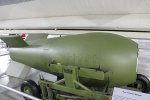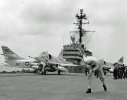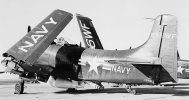AOA is a function of airspeed. You made my point. AOA is a certain airspeed for a certain angle of attack. Remember those airspeed/AOA cross-checks on approach? If the failure of an AOA probe is critical for takeoff then that’s a design flaw. Since I am guilty of flying older airplanes, it’s set an attitude and accelerate. Off a runway, it’s at a computed speed. Off the Cat it’s an end speed. I think we are talking around each other. I get what you’re saying but at the end the day it’s end speed not AOA.Demonstrably false. AOA is a function of airspeed, so off the end of the cat stroke it means something in a very real and immediate sense. In order to keep catapult end speeds within reasonable bounds, a lot of the older delta-winged aircraft used a longer nose landing gear to sit at a higher angle, inducing an AOA during the cat stroke to prevent settle. Extra room for large stores under the jet was an ancillary benefit.
Later designs like the F/A-18 and F-35 did away with some of this due to a number of features like leading edge extensions, leading edge flaps, and a high degree of control power stemming from their large horizontal stabilators. In the F/A-18, the highest AOA in the terminal environment is just off the cat as the aircraft accelerates under its own power and rotates based on stabilator trim setting (hands-free so the pilot doesn't over or under-rotate). With the gear and flaps down, the jet is seeking alpha (AOA), just like it does during an approach, so the loss of an AOA probe can cause pitch excursions immediately off the cat. Ask me how I know.
-
Please take a moment and update your account profile. If you have an updated account profile with basic information on why you are on Air Warriors it will help other people respond to your posts. How do you update your profile you ask?
Go here:
Edit Account Details and Profile
You are using an out of date browser. It may not display this or other websites correctly.
You should upgrade or use an alternative browser.
You should upgrade or use an alternative browser.
Scooters Forever (A-4 Skyhawk Tribute Thread)
- Thread starter ea6bflyr
- Start date
AOA is a function of airspeed. You made my point. AOA is a certain airspeed for a certain angle of attack. Remember those airspeed/AOA cross-checks on approach? If the failure of an AOA probe is critical for takeoff then that’s a design flaw. Since I am guilty of flying older airplanes, it’s set an attitude and accelerate. Off a runway, it’s at a computed speed. Off the Cat it’s an end speed. I think we are talking around each other. I get what you’re saying but at the end the day it’s end speed not AOA.
Yeah, we're definitely talking around each other. I'll take "coefficient of lift" for 1000, Alex.
This whole section of the thread started because of the discussion about landing gear design of the A4 and its induced AOA by design. That doesn't make sense to you? Your original post said AOA doesn't mean jack coming off the cat, which simply isn't true. You need speed and AOA in order to generate enough lift to fly away. Coming off at 200 knots with zero AOA on the wing won't be enough- at least not without rotation to a positive AOA. Similarly, coming off at 14 degrees AOA and 50 knots isn't gonna work either. Clear enough?
We are certainly talking around each other! My point is that nobody flys AOA on takeoff or off the Cat (except apparently new generation aircraft)Yeah, we're definitely talking around each other. I'll take "coefficient of lift" for 1000, Alex.
This whole section of the thread started because of the discussion about landing gear design of the A4 and its induced AOA by design. That doesn't make sense to you? Your original post said AOA doesn't mean jack coming off the cat, which simply isn't true. You need speed and AOA in order to generate enough lift to fly away. Coming off at 200 knots with zero AOA on the wing won't be enough- at least not without rotation to a positive AOA. Similarly, coming off at 14 degrees AOA and 50 knots isn't gonna work either. Clear enough?
Because they don’t have catapults?The Brits have ramps for a reason.

Behind it is the Navy’s strategic nuclear bomber, the A-3 Skywarrior. The Skywarrior’s daddy was the propeller driven AJ Savage.Here's another photo of a Mark 7 bomb on a Scooter -- this time on the cat on USS Saratoga. Note that the bottom fin was retracted until after takeoff. Plenty of clearance.View attachment 39732
The whole rationale for the heavy attack aircraft (AJ, then A-3) was to carry the large weapons of the early period. The Mark 5 (pictured) was 43.75 inches in diameter, about 130 inches long and weighed 3,000+ pounds. When the Mark 7 came along, we could finally contemplate using something more reasonably sized for the mission. The Whale took up a lot of deck space!Behind it is the Navy’s strategic nuclear bomber, the A-3 Skywarrior. The Skywarrior’s daddy was the propeller driven AJ Savage.

I went to Gitmo for a weeks-long E2 drug interdiction det in my fleet squadron back in 1988. I was a brand new Ensign Null-P in the squadron, shut up and do what I'm told. We took a day off to relax and have a picnic.
I walked over to the A4 squadron in the hangar where I knew a guy from flight school, and asked if it'd be possible to maybe go for a ride while I was there. The Ops guy asked if my leadership was cool with it, I lied and said yes. He said he was getting ready to go fly, and I was welcome to jump in. Sweet! Grabbed my harness, borrowed a G-suit, and off we went. I remember he was pre-flighting, and stood up underneath the wing and all but drove this metal lever sticking down right through his skull. His eyes uncaged for a moment and he was bleeding over his forehead, but wiped it up and we manned up.
Got into the bombing pattern over the base and dropped little blue ones on a school bus on the range, then strafed it a few times. Went off the coast and zorched around for a bit. Got back in the landing pattern and he let me take it for a couple of laps. I waved at my squadron mates at the approach end picnic area, who were no longer wondering where I was off to. I was pretty stoked about the whole thing.
The det OIC really didn't know if he should be pissed or not. Good show of initiative? I pled juniority and promised to either not to it again, or not tell anyone I did it.
I walked over to the A4 squadron in the hangar where I knew a guy from flight school, and asked if it'd be possible to maybe go for a ride while I was there. The Ops guy asked if my leadership was cool with it, I lied and said yes. He said he was getting ready to go fly, and I was welcome to jump in. Sweet! Grabbed my harness, borrowed a G-suit, and off we went. I remember he was pre-flighting, and stood up underneath the wing and all but drove this metal lever sticking down right through his skull. His eyes uncaged for a moment and he was bleeding over his forehead, but wiped it up and we manned up.
Got into the bombing pattern over the base and dropped little blue ones on a school bus on the range, then strafed it a few times. Went off the coast and zorched around for a bit. Got back in the landing pattern and he let me take it for a couple of laps. I waved at my squadron mates at the approach end picnic area, who were no longer wondering where I was off to. I was pretty stoked about the whole thing.
The det OIC really didn't know if he should be pissed or not. Good show of initiative? I pled juniority and promised to either not to it again, or not tell anyone I did it.
Got my first choice out of flight school, A-4M. At the time there was a 6 month pool at the RAG in Yuma so orders in hand the the HAMs squadron in Cherry Point where they said I could fly the OA-4 since we came out of flight school with an A-4 NATOPS qual. The day I checked in they told me I had to go over to the group and talk to them. The next day I classed up at VMA(AW) 202. Never got a chance to fly the A-4 again. Would have loved to fly that bird.My favorite A-4 : OA-4M - the ultimate Scooter!

Last edited:
That's one COA to get a ride...The det OIC really didn't know if he should be pissed or not. Good show of initiative? I pled juniority and promised to either not to it again, or not tell anyone I did it.
Another COA is to steal one.

All Counts Dropped Against Marine for Jet Fighter Joy Ride
All charges against an El Toro Marine corporal who took a jet fighter on a Fourth of July joy ride have been dropped and he will be discharged from the military today, the Marine Corps announced Thursday.
Probably a best practice to check the open MAFs beforehand though.
One of my sim instructors in the Hornet RAG was the Station Duty Officer that day…crazy story.That's one COA to get a ride...
Another COA is to steal one.

All Counts Dropped Against Marine for Jet Fighter Joy Ride
All charges against an El Toro Marine corporal who took a jet fighter on a Fourth of July joy ride have been dropped and he will be discharged from the military today, the Marine Corps announced Thursday.www.latimes.com
Probably a best practice to check the open MAFs beforehand though.
Guy ended up working as an aeronautical engineer and test pilot, qualified in 20+ different military and civilian aircraft. He was (or might still be) working with NASA’s Jet Propulsion Laboratory. He also holds a number of patents in aviation design and engineering technology. Not bad for a corporal with an Other Than Honorable ticket.That's one COA to get a ride...
Another COA is to steal one.

All Counts Dropped Against Marine for Jet Fighter Joy Ride
All charges against an El Toro Marine corporal who took a jet fighter on a Fourth of July joy ride have been dropped and he will be discharged from the military today, the Marine Corps announced Thursday.www.latimes.com
Probably a best practice to check the open MAFs beforehand though.


